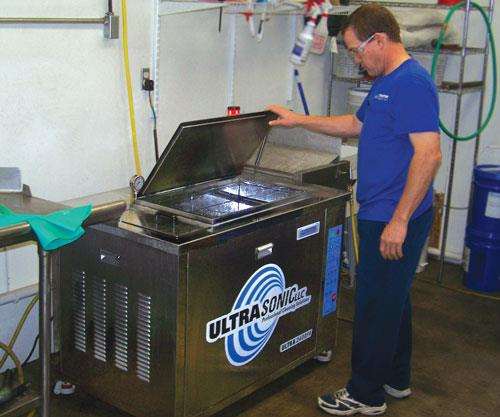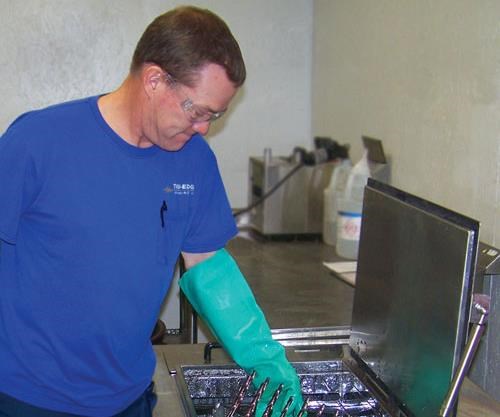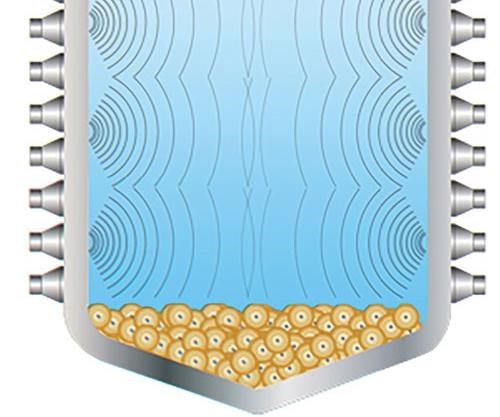Ultrasonic Technology Takes Tool Cutter Beyond the Same Old Grind
Failure to remove oils and dirt from tooling prior to batch coating leads to contamination of an entire vessel of coating materials, but a new agitation pre-cleaner is helping this shop remove more of the oils and dirt while significantly shortening the cycle time.
Tru-Edge Cutting Tool Services designs and manufactures custom round cutting tools and provides regrinding and coating services for customers in the aerospace, automotive, medical, food service and mining industries, among others. Failure to remove oils and dirt from tooling prior to batch coating leads to contamination of an entire vessel of coating materials, but at Tru-Edge, a new agitation pre-cleaner is helping to remove more of the oils and dirt while significantly shortening the cycle time. This combination yields a short payback for this west-central Ohio manufacturer.
Streamlining the Process
Featured Content
Established as a tool regrinding and reconditioning service in 1996, the company has expanded to provide turnkey engineering and tool designing solutions, custom and modified tool manufacturing, and a complete in-house coating system. The company grinds and refurbishes solid carbide, coolant-fed carbide, carbide tipped, high speed steel and cobalt high speed steel cutting tools. It services tooling for end mills, drills, taps, gun drills, reamers, port tools, multi-function tools and modified and custom-manufactured tools.
Whether manufacturing custom designed cutting tools or re-sharpening existing ones, the process is a dirty one. Tooling gets covered with dirt, oils and shavings throughout the process. Products that are headed for the coatings process must have all of the oils and dirt removed prior to coating or the stray dirt will contaminate the entire vessel of coating material. Since Tru-Edge coats with a variety of substances (many of them high-value materials), a contaminated batch can cost between $500 and $5,000. Uncoated product must also be cleaned before being shipped to customers, requiring the pre-cleaner and the finish cleaner to operate continuously throughout the day.
While the company had been using a traditional ultrasonic cleaner as a pre-cleaning step, this machine had limited success removing the penetrating oils. Most of the burden was on the heated vacuum ultrasonic cleaner. Seeking to make the task easier for this $80,000 piece of equipment (and its very expensive cleaning fluids), Tru-Edge Director of Manufacturing David Balster began researching options.
“We looked for over a year at 15 to 20 different brands until we found an ultrasonic cleaner that was different,” Mr. Balster recalls. He purchased a model Ultra 2400FA from UltraSonic LLC in August 2015. “These are the only ones with ultrasonic emitters on the sides rather than the bottom, where the waves don’t necessarily hit the tools,” he says.
This direct pathway produces direct results in terms of a faster cleaning cycle. Tru-Edge has reduced cycle time from 10 minutes to 3 minutes. That reduction, coupled with a larger cleaning tank, allows more parts to be cleaned per hour and helps with turnaround for the coating department. It also yields a 6-month payback for this capital investment, based on labor savings.
Not only is the cleaning faster, the side-mounted ultrasonics with agitation/oscillation also significantly outperforms the company’s previous ultrasonic pre-cleaner. Mr. Balster compares the reduced levels of contaminants in the detergents and tanks of the company’s finish cleaner, which is expensive to own and operate. Reduction in contaminant loading means that the cleaning solutions last longer. While data is still being gathered, and numbers crunched, preliminary figures indicate that the final machine cleaning fluid lasts almost twice as long, providing an additional cost savings and shorter payback for the UltraSonic LLC machine. Mr. Balster estimates that cleaning is probably 300 to 400 percent better in a third of the time.
How Ultrasonics Works
Ultrasonic cleaning is a precision parts cleaning technology that uses high frequency sound waves to remove dirt and contaminants from parts. Micron-size bubbles are formed from the alternating pressure waves generated from the high energy transducers. Energy is transferred to and stored within these bubbles. As the bubbles contact the parts to be cleaned, they implode, releasing the stored energy and creating a micro jet, with a kind of scrubbing action that dislodges contaminants from the parts. Dirt, oils and other dislodged contaminants then settle to the bottom of the tank.
The process of formation and collapse/implosion of these tiny bubbles is called cavitation and is common to all ultrasonic cleaners. What is unique about the UltraSonic LLC technology is the placement of the transducers on the tank’s side rather than the bottom. Side-mounting the transducers provides a consistent cleaning action from top to bottom, with no “blind spots.” A V-shaped bottom allows the dirt to collect there without interfering in the transducer’s wave path and contributes to easy cleaning.
The system that Tru-Edge uses has a 24-gallon main tank, a 6-gallon weir tank, and a working depth of 14 inches. The agitation table capacity of 100 pounds is more than sufficient for the varied sized batches of tooling and parts that the company cleans. Working from 120V and drawing only 18 amps, the system could be easily accommodated by the existing electrical system. Compact machine dimensions (45-inch L × 28.5-inch W × 33-inch H) allow it to easily fit into existing shop space with a minimal footprint. Digital touch controls are designed for easy operation with automatic ultrasonic, agitation and filtration cycles. A 7-day heat and auxiliary timer allows programming to suit production requirements as needed.
Everything in its Place
Ultrasonic cleaning technology, and the cavitation that is key to its success, has been around for decades. However, as Mr. Balster and his Tru-Edge team found, different machine designs have their own unique aspects. Tru-Edge is reaping the benefits of patience and diligence during its search for a better pre-cleaner. The UltraSonic LLC machine is removing more of the oils and contaminants than ever before, and it is removing that burden from the expensive heated vacuum ultrasonic cleaner. Additionally, faster turnaround time in the pre-cleaner and final cleaner has helped turnaround time in the coating department, further streamlining operations.
“We’re removing a lot more of the gunk with these units so that our more expensive cleaner can do a better job,” Mr. Balster says. “Together, they’re turning out a superior product in less time.”
Drastically reducing cycle times and better cleaning efficiencies are allowing this busy plant to maintain high production levels and high quality standards without sacrificing margins. Clearly, it’s not “the same old grind” here at Tru-Edge.
RELATED CONTENT
-
Cleaning Parts Cost Effectively
A shop should look at all aspects of the production process to maximize productivity. This includes selecting an efficient cleaning system.
-
Automated Cleaning System Improves Productivity
This rotary basket washer drastically reduced the number of operators tending to the cleaning process as well as removed the bottleneck from that station.
-
Cleanliness Compliance is Critical for Automotive Suppliers
Although not every shop has been affected by cleanliness specifications, many suppliers to automotive OEMs are already complying with stringent cleanliness standards. In Ford Motor Co.’s case, it has created its own cleanliness standards in order to save money and credibility.









